The global sachet packaging market is projected to grow from USD 11.2 billion in 2025 to approximately USD 28.5 billion by 2035, recording an absolute increase of USD 17.4 billion over the forecast period. This translates into a total growth of 155.4%, with the market forecast to expand at a CAGR of 9.8% between 2025 and 2035. The market size is expected to grow by approximately 2.6X during the same period, supported by increasing demand for convenient single-serve packaging, growing adoption across consumer goods industries, and rising requirements for cost-effective packaging solutions across global retail and distribution sectors.
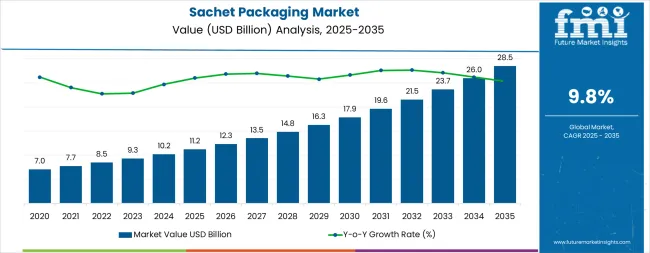
Between 2025 and 2030, the sachet packaging market is projected to grow from USD 11.2 billion to USD 17.8 billion, increasing by USD 6.6 billion, representing 37.9% of the total decade growth. This growth will be driven by rising demand for affordable unit-dose packaging, consumer preference for trial-size products, and expanding availability across retail and distribution channels. From 2030 to 2035, the market is expected to grow from USD 17.8 billion to USD 28.5 billion, adding USD 10.8 billion, constituting 62.1% of the decade's growth. Advancements in barrier film technologies, innovative sealing systems, and premium multi-layer sachets will shape this period. The emphasis on product freshness and portion control will drive demand for packaging with improved moisture barriers, oxygen protection, and preservation characteristics. Between 2020 and 2024, the market grew due to rising awareness of convenience packaging, with sachets gaining popularity in retail and emerging markets as affordable, accessible solutions for consumers.
| Metric | Value |
|---|---|
| Estimated Value in (2025E) | USD 11.2 billion |
| Forecast Value in (2035F) | USD 28.5 billion |
| Forecast CAGR (2025 to 2035) | 9.8% |
The sachet packaging market is primarily driven by several key parent markets, with the packaging industry being the largest contributor, accounting for around 40-45%. Sachets are highly popular due to their versatility, convenience, and cost-effectiveness, making them ideal for packaging small quantities of liquids, powders, and granular products. Their compact size caters to single-use applications, especially in sectors where portability is key, such as for packaging shampoo, sauces, and detergents. The food and beverage market, contributing about 25-30%, also plays a significant role, with sachets being widely used for single-serve items like ketchup, mustard, tea, coffee, and beverages. The growing consumer demand for portion-controlled packaging that ensures freshness and reduces wastage drives the growth of this segment.
The cosmetics and personal care market, holding around 15-20%, benefits from sachet packaging for single-use samples of skincare products, cosmetics, and toiletries. Sachets offer consumers an affordable and convenient way to try products without committing to full-size purchases, making them popular for travel-sized items.
The pharmaceutical market, which contributes around 10-12%, utilizes sachets for packaging single-dose medications, powders, granules, and liquid formulations, offering a practical and hygienic solution for precise dosage and preventing contamination. The household and industrial products market, which accounts for approximately 5-8%, utilizes sachets for packaging detergents, cleaning agents, and chemicals, driven by the need for portable and cost-effective packaging solutions.
Market expansion is being supported by the increasing global demand for convenient packaging solutions and the corresponding shift toward single-serve formats that can provide superior accessibility outcomes while meeting consumer requirements for affordability and trial-friendly purchasing processes. Modern consumers are increasingly focused on incorporating portion-controlled solutions that can enhance product sampling while satisfying demands for flexible, consistently performing packaging and optimized usage practices. Sachet packaging's proven ability to deliver convenience benefits, cost efficiency, and diverse application possibilities makes it an essential product for consumer goods manufacturers and distribution-focused organizations.
The growing emphasis on market penetration and consumer accessibility is driving demand for high-quality sachet packaging that can support distinctive branding outcomes and comprehensive product positioning across personal care products, food condiments, and pharmaceutical categories. Consumer preference for products that combine affordability with convenience characteristics is creating opportunities for innovative implementations in both traditional and emerging market applications. The rising influence of retail distribution and emerging market initiatives is also contributing to increased adoption of sachets that can provide authentic accessibility benefits and trial characteristics.
The market is segmented by product type, material type, end-use industry, and region. By product type, the market is divided into single-use sachets, multi-use sachets, stick packs, pillow sachets, flat sachets, three-side seal sachets, and other sachet formats. Based on material type, the market is categorized into plastic films, aluminum foil, paper-based materials, and multi-layer laminates. By end-use industry, the market includes personal care, food & beverages, pharmaceuticals, nutraceuticals, household products, and other industries. Regionally, the market is divided into North America, Europe, Asia Pacific, Latin America, Middle East & Africa, and other regions.
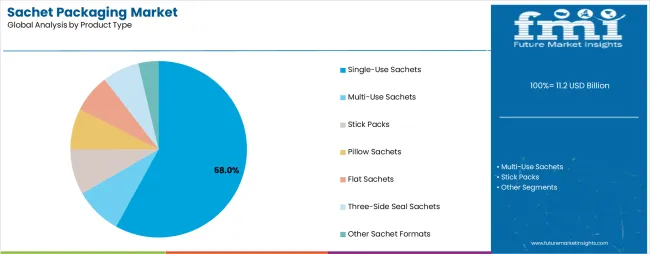
The single-use sachets segment is projected to account for 58% of the sachet packaging market in 2025, reaffirming its position as the leading product category. Manufacturers and brands increasingly utilize single-use sachets for their superior convenience characteristics, established portion control, and essential functionality in product sampling applications across diverse consumer categories. Single-use sachets' standardized dispensing characteristics and proven convenience effectiveness directly address consumer requirements for trial-friendly packaging and optimal affordability value in retail applications.
This product segment forms the foundation of modern convenience packaging patterns, as it represents the format with the greatest consumer acceptance potential and established compatibility across multiple product systems. Brand investments in market penetration optimization and accessibility standardization continue to strengthen adoption among cost-conscious organizations. With consumers prioritizing product trial and convenience reliability, single-use sachets align with both accessibility objectives and affordability requirements, making them the central component of comprehensive market entry strategies.
Plastic films are projected to represent 44% of the sachet packaging market growth through 2035, underscoring their critical role as the primary choice for flexibility-focused manufacturers seeking superior barrier benefits and enhanced processing credentials. Brand users and packaging converters prefer plastic films for their enhanced versatility standards, proven cost-effectiveness, and ability to maintain exceptional barrier profiles while supporting high-speed production during automated filling experiences. Positioned as essential materials for efficient manufacturers, plastic film offerings provide both barrier excellence and processing advantages.
The segment is supported by continuous improvement in film extrusion technology and the widespread availability of established converting infrastructure that enables quality assurance and efficient positioning at the commercial level. Packaging manufacturers are optimizing plastic film processing methods to support market differentiation and accessible pricing. As materials technology continues to advance and brands seek superior barrier solutions, plastic films will continue to drive market growth while supporting product preservation and commercial packaging strategies.
The sachet packaging market is advancing rapidly due to increasing consumer convenience consciousness and growing need for affordable packaging choices that emphasize superior accessibility outcomes across emerging market segments and retail applications. The market faces challenges, including environmental concerns regarding single-use packaging, recycling infrastructure limitations, and material cost volatility affecting pricing stability. Innovation in recyclable materials and efficient production development continues to influence market development and expansion patterns.
The growing adoption of sachet packaging in developing economy programs and price-sensitive applications is enabling brands to develop distribution patterns that provide distinctive accessibility benefits while commanding volume positioning and enhanced market penetration characteristics. Emerging market applications provide superior affordability density while allowing more extensive consumer reach across various retail categories. Brands are increasingly recognizing the competitive advantages of sachet positioning for market entry and accessibility-conscious distribution integration.
Modern sachet packaging manufacturers are incorporating advanced lamination systems, high-speed filling technologies, and quality management protocols to enhance preservation capabilities, improve consumer outcomes, and meet brand demands for product-specific barrier solutions. These systems improve packaging effectiveness while enabling new applications, including tamper-evident features and specialized configuration programs. Advanced barrier integration also allows manufacturers to support premium market positioning and preservation leadership beyond traditional packaging operations.
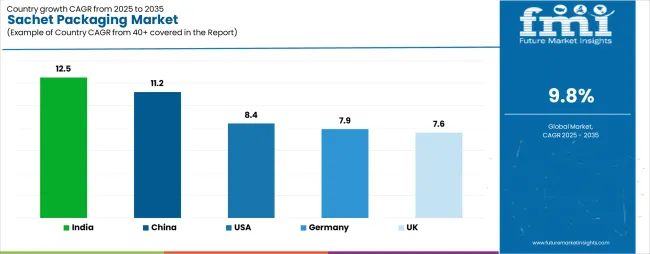
| Country | CAGR (2025-2035) |
|---|---|
| USA | 8.4% |
| Germany | 7.9% |
| UK | 7.6% |
| China | 11.2% |
| India | 12.5% |
The sachet packaging market is experiencing robust growth globally, with India leading at a 12.5% CAGR through 2035, driven by the expanding consumer goods sector, growing rural market penetration, and increasing adoption of affordable packaging products. China follows at 11.2%, supported by rising consumer demand, expanding retail infrastructure, and growing acceptance of convenient packaging solutions. The USA shows growth at 8.4%, emphasizing established consumer markets and comprehensive distribution development. Germany records 7.9%, focusing on premium barrier products and efficient packaging expansion. The UK demonstrates 7.6% growth, prioritizing convenience packaging solutions and technological advancement.
The report covers an in-depth analysis of 40+ countries, with the top-performing countries are highlighted below.
Revenue from sachet packaging consumption and sales in India is projected to exhibit exceptional growth with a CAGR of 12.5% through 2035, driven by the country's rapidly expanding rural consumer sector, favorable demographic attitudes toward affordable packaging, and initiatives promoting consumer product accessibility across major retail regions. India's position as a leading emerging market and increasing focus on market penetration development are creating substantial demand for high-quality sachets in both urban and rural markets. Major consumer goods suppliers and specialty packaging providers are establishing comprehensive distribution capabilities to serve growing consumer demand and emerging accessibility opportunities.
Demand for sachet packaging products in China is expanding at a CAGR of 11.2%, supported by rising consumer sophistication, growing retail precision, and expanding packaging production infrastructure. The country's developing manufacturing capabilities and increasing brand investment in convenient packaging are driving demand for sachets across both domestic and export applications. International consumer goods companies and domestic manufacturers are establishing comprehensive production networks to address growing market demand for quality sachets and flexible packaging solutions.
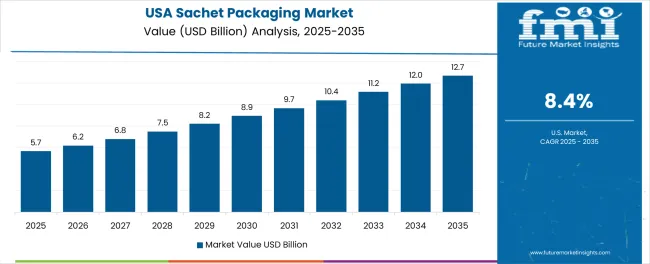
Revenue from sachet packaging products in the USA is projected to grow at a CAGR of 8.4% through 2035, supported by the country's mature consumer goods market, established convenience culture, and leadership in quality standards. America's sophisticated retail infrastructure and strong support for product innovation are creating steady demand for both traditional and innovative sachet varieties. Leading consumer brands and specialty packaging providers are establishing comprehensive operational strategies to serve both domestic markets and growing export opportunities.
The sale of sachet packaging products in Germany is anticipated to grow at a CAGR of 7.9% through 2035, driven by the country's emphasis on packaging quality, environmental responsibility, and sophisticated barrier capabilities for consumer products requiring specialized protective varieties. German manufacturers and brands consistently seek premium-grade solutions that enhance product preservation and support consumer convenience for both traditional and innovative packaging applications. The country's position as a European manufacturing leader continues to drive innovation in specialty sachet applications and quality product standards.
Revenue from sachet packaging products in the UK is expected to expand at a CAGR of 7.6% through 2035, supported by the country's emphasis on retail innovation, consumer convenience standards, and advanced distribution integration requiring efficient packaging solutions. British consumers and retailers prioritize convenience, performance, and portion control, making sachets essential components for both traditional and modern retail applications. The country's comprehensive retail excellence and advancing consumer patterns support continued market expansion.
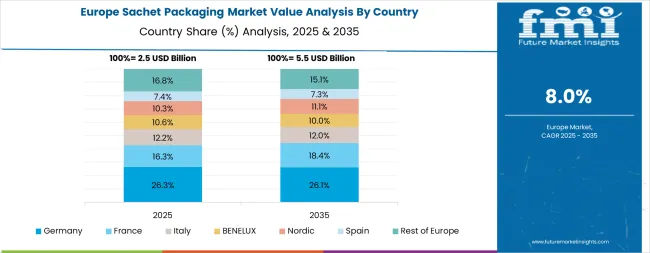
The Europe sachet packaging market is projected to grow from USD 2.9 billion in 2025 to USD 6.8 billion by 2035, recording a CAGR of 8.9% over the forecast period. Germany leads the region with a 29.0% share in 2025, moderating slightly to 28.5% by 2035, supported by its strong packaging culture and demand for premium, efficiently engineered sachet solutions. The United Kingdom follows with 21.0% in 2025, easing to 20.5% by 2035, driven by a sophisticated retail market and emphasis on convenience and quality standards. France accounts for 19.5% in 2025, rising to 20.0% by 2035, reflecting steady adoption of flexible packaging solutions and consumer accessibility consciousness. Italy holds 13.0% in 2025, expanding to 13.8% by 2035 as retail modernization and specialty consumer applications grow. Spain contributes 9.0% in 2025, growing to 9.5% by 2035, supported by expanding consumer goods and affordable packaging handling. The Nordic countries rise from 5.5% in 2025 to 6.0% by 2035 on the back of strong convenience adoption and advanced retail integration. BENELUX remains a stable 3.0% share across both 2025 and 2035, reflecting mature, quality-focused markets.
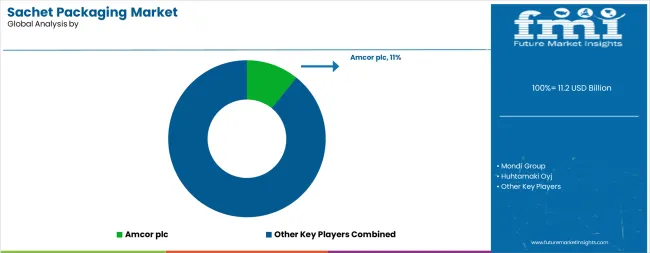
The sachet packaging market is characterized by competition among established flexible packaging companies, specialized sachet manufacturers, and integrated packaging solution providers. Companies are investing in barrier technologies, advanced filling systems, product innovation capabilities, and comprehensive distribution networks to deliver consistent, high-quality, and efficient sachet packaging. Innovation in barrier enhancement, high-speed production methods, and application-specific product development is central to strengthening market position and customer satisfaction.
Amcor plc leads the market with a strong focus on flexible packaging innovation and comprehensive sachet solutions, offering premium packaging with emphasis on barrier excellence. Mondi Group provides specialized flexible packaging capabilities with a focus on European market applications and custom design networks. Huhtamaki Oyj delivers integrated packaging solutions with a focus on quality positioning and operational efficiency. Constantia Flexibles specializes in comprehensive barrier packaging with an emphasis on pharmaceutical applications. Sonoco Products Company focuses on comprehensive consumer solutions with advanced production and premium positioning capabilities.
The success of sachets in meeting consumer convenience demands, affordability-driven accessibility requirements, and quality assurance integration will not only enhance packaging outcomes but also strengthen global consumer goods capabilities. It will consolidate emerging regions' positions as hubs for efficient sachet production and align advanced economies with modern packaging systems. This calls for a concerted effort by all stakeholders -- governments, industry bodies, manufacturers, distributors, and investors. Each can be a crucial enabler in preparing the market for its next phase of growth.
How Governments Could Spur Local Production and Adoption?
How Industry Bodies Could Support Market Development?
How Distributors and Consumer Goods Players Could Strengthen the Ecosystem?
How Manufacturers Could Navigate the Shift?
| Items | Values |
|---|---|
| Quantitative Units (2025) | USD 11.2 billion |
| Product Type | Single-Use Sachets, Multi-Use Sachets, Stick Packs, Pillow Sachets, Flat Sachets, Three-Side Seal Sachets, Other Sachet Formats |
| Material Type | Plastic Films, Aluminum Foil, Paper-Based Materials, Multi-Layer Laminates |
| End-Use Industry | Personal Care, Food & Beverages, Pharmaceuticals, Nutraceuticals, Household Products, Other Industries |
| Regions Covered | North America, Europe, Asia Pacific, Latin America, Middle East & Africa, Other Regions |
| Countries Covered | India, China, United States, Germany, United Kingdom, and 40+ countries |
| Key Companies Profiled | Amcor plc, Mondi Group, Huhtamaki Oyj, Constantia Flexibles, Sonoco Products Company, and other leading sachet packaging companies |
| Additional Attributes | Dollar sales by product type, material type, end-use industry, and region; regional demand trends, competitive landscape, technological advancements in materials engineering, barrier design integration initiatives, quality enhancement programs, and premium product development strategies |
The global sachet packaging market is estimated to be valued at USD 11.2 billion in 2025.
The market size for the sachet packaging market is projected to reach USD 28.5 billion by 2035.
The sachet packaging market is expected to grow at a 9.8% CAGR between 2025 and 2035.
The key product types in sachet packaging market are single-use sachets, multi-use sachets, stick packs, pillow sachets, flat sachets, three-side seal sachets and other sachet formats.
In terms of end-use industry, personal care segment to command 36.0% share in the sachet packaging market in 2025.






Our Research Products

The "Full Research Suite" delivers actionable market intel, deep dives on markets or technologies, so clients act faster, cut risk, and unlock growth.

The Leaderboard benchmarks and ranks top vendors, classifying them as Established Leaders, Leading Challengers, or Disruptors & Challengers.

Locates where complements amplify value and substitutes erode it, forecasting net impact by horizon

We deliver granular, decision-grade intel: market sizing, 5-year forecasts, pricing, adoption, usage, revenue, and operational KPIs—plus competitor tracking, regulation, and value chains—across 60 countries broadly.

Spot the shifts before they hit your P&L. We track inflection points, adoption curves, pricing moves, and ecosystem plays to show where demand is heading, why it is changing, and what to do next across high-growth markets and disruptive tech

Real-time reads of user behavior. We track shifting priorities, perceptions of today’s and next-gen services, and provider experience, then pace how fast tech moves from trial to adoption, blending buyer, consumer, and channel inputs with social signals (#WhySwitch, #UX).

Partner with our analyst team to build a custom report designed around your business priorities. From analysing market trends to assessing competitors or crafting bespoke datasets, we tailor insights to your needs.
Supplier Intelligence
Discovery & Profiling
Capacity & Footprint
Performance & Risk
Compliance & Governance
Commercial Readiness
Who Supplies Whom
Scorecards & Shortlists
Playbooks & Docs
Category Intelligence
Definition & Scope
Demand & Use Cases
Cost Drivers
Market Structure
Supply Chain Map
Trade & Policy
Operating Norms
Deliverables
Buyer Intelligence
Account Basics
Spend & Scope
Procurement Model
Vendor Requirements
Terms & Policies
Entry Strategy
Pain Points & Triggers
Outputs
Pricing Analysis
Benchmarks
Trends
Should-Cost
Indexation
Landed Cost
Commercial Terms
Deliverables
Brand Analysis
Positioning & Value Prop
Share & Presence
Customer Evidence
Go-to-Market
Digital & Reputation
Compliance & Trust
KPIs & Gaps
Outputs
Full Research Suite comprises of:
Market outlook & trends analysis
Interviews & case studies
Strategic recommendations
Vendor profiles & capabilities analysis
5-year forecasts
8 regions and 60+ country-level data splits
Market segment data splits
12 months of continuous data updates
DELIVERED AS:
PDF EXCEL ONLINE
Sachet Packaging Machines Market Size and Share Forecast Outlook 2025 to 2035
Sachet Packaging Industry Analysis in Asia Pacific - Size, Share, and Forecast 2025 to 2035
Market Leaders & Share in the Sachet Packaging Machines Industry
Competitive Overview of Sachet Packaging Market Share
USA Sachet Packaging Market Report – Trends, Demand & Industry Outlook 2025-2035
ASEAN Sachet Packaging Market Analysis – Size, Share & Forecast 2025-2035
Japan Sachet Packaging Market Outlook – Share, Growth & Forecast 2025-2035
Germany Sachet Packaging Market Trends – Size, Share & Growth 2025-2035
Asia Pacific Sachet Packaging Machines Market Size and Share Forecast Outlook 2025 to 2035
Middle East & Africa Sachet Packaging Machines Market Size and Share Forecast Outlook 2025 to 2035
Packaging Supply Market Size and Share Forecast Outlook 2025 to 2035
Packaging Testing Services Market Size and Share Forecast Outlook 2025 to 2035
Packaging Tubes Market Size and Share Forecast Outlook 2025 to 2035
Packaging Jar Market Forecast and Outlook 2025 to 2035
Packaging Barrier Film Market Size and Share Forecast Outlook 2025 to 2035
Packaging Films Market Size and Share Forecast Outlook 2025 to 2035
Packaging Laminate Market Size and Share Forecast Outlook 2025 to 2035
Packaging Burst Strength Test Market Size and Share Forecast Outlook 2025 to 2035
Packaging Tapes Market Analysis - Size, Share, & Forecast Outlook 2025 to 2035
Packaging Materials Market Size and Share Forecast Outlook 2025 to 2035

Thank you!
You will receive an email from our Business Development Manager. Please be sure to check your SPAM/JUNK folder too.
Chat With
MaRIA